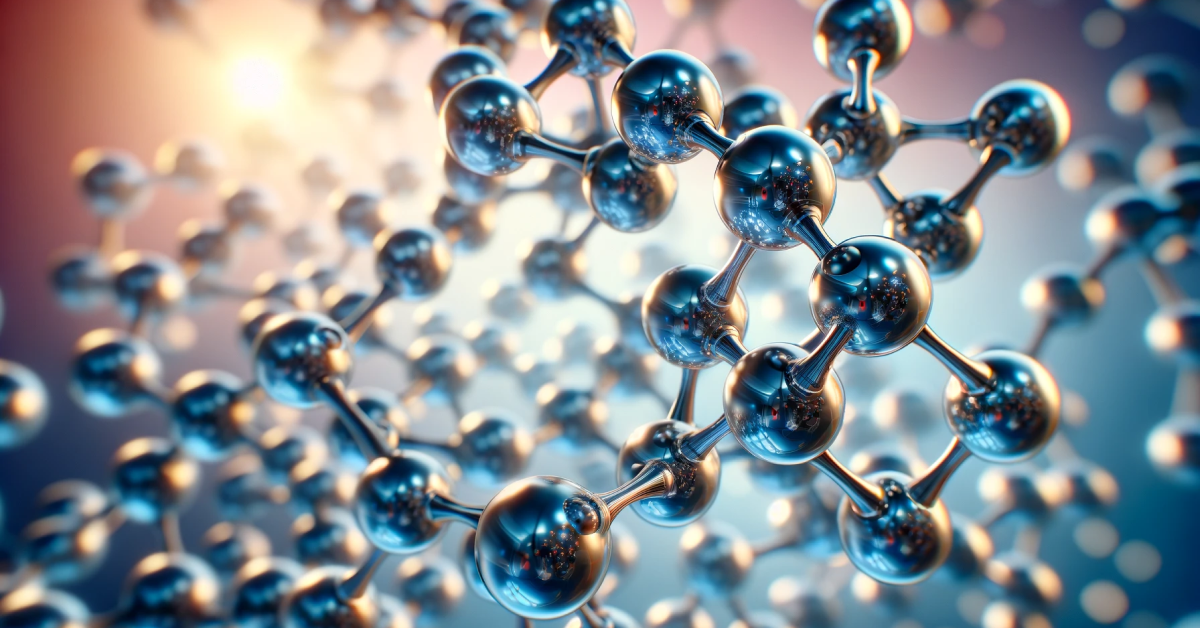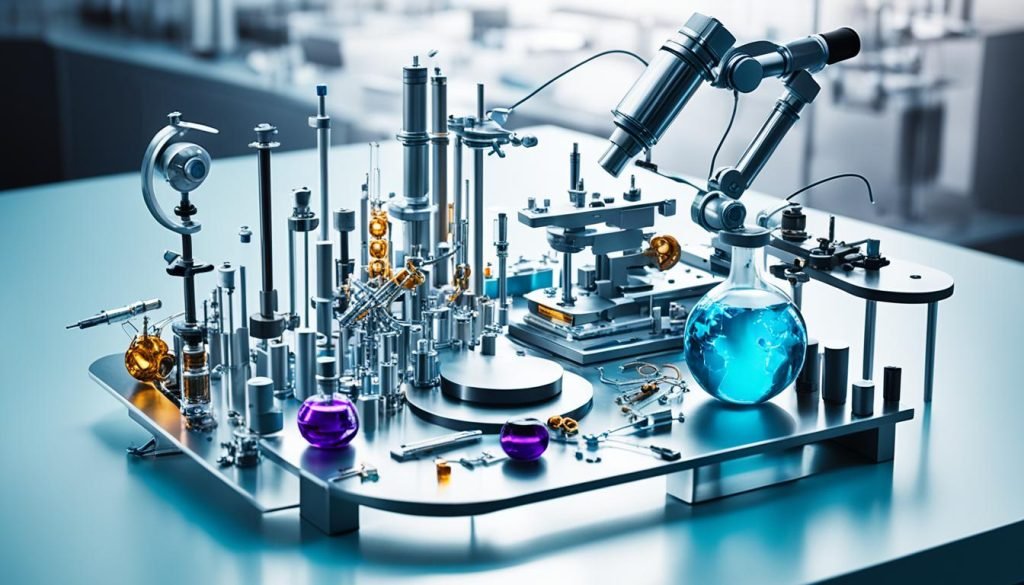
Did you know that nanotechnology research is driving breakthroughs and advancements across various industries, with the potential to revolutionize our world? Nanotechnology, the study and manipulation of matter at the nanoscale, has opened up endless possibilities for innovation and problem-solving. It encompasses a wide range of scientific disciplines, including physics, chemistry, materials science, and biology, making it a truly interdisciplinary field.

Key Takeaways:
- Nanotechnology research is leading to significant advancements and innovations in various industries.
- Nanotechnology involves the study and manipulation of matter at the nanoscale.
- It is an interdisciplinary field that combines physics, chemistry, materials science, and biology.
- The potential of nanotechnology extends to healthcare, electronics, environmental remediation, and more.
- Careful attention must be given to safety, ethical considerations, and environmental impacts in nanotechnology development.
The Value of Nanomaterials and Current Applications
Nanomaterials, with their versatile properties, have become incredibly valuable in various technology sectors. Both the US government and industrial sector have recognized their potential, leading to substantial investments in nanotechnology research and development. Currently, the US government invests nearly $1 billion annually in nanotechnology.
Industrial investment in nanotechnology is also on the rise, with the successful commercialization of nanomaterials that were once only a part of science fiction. These investments have propelled the development of nanotechnology applications across different industries.
- Transparent sunscreen: Nanomaterials provide enhanced protection against harmful UV rays while maintaining transparency on the skin.
- Sporting equipment: Nanomaterials are integrated into sports gear to enhance performance, durability, and safety.
- Clothing: Nanotechnology-treated fabrics offer stain resistance, antimicrobial properties, and moisture-wicking abilities.
- Telecommunication infrastructure: Nanomaterials are used in the development of advanced devices, antennas, and circuits for efficient communication.
- Fuel cells: Nanotechnology plays a crucial role in the design and manufacturing of highly efficient fuel cells for clean energy production.
Nanotechnology applications in these areas have already demonstrated their practical use and benefits, shaping the future of various industries.
To illustrate the current applications of nanotechnology, consider the following table:
| Industry | Application | Benefits |
|---|---|---|
| Sunscreen | Transparent sunscreen using nanomaterials | Provides effective protection against UV radiation while maintaining transparency on the skin |
| Sports | Nanotechnology-treated sporting equipment | Enhances performance, durability, and safety |
| Clothing | Nanotechnology-treated fabrics | Offers stain resistance, antimicrobial properties, and moisture-wicking abilities |
| Telecommunication | Nanomaterials in advanced devices, antennas, and circuits | Enables efficient and reliable communication infrastructure |
| Energy | Highly efficient fuel cells | Contributes to clean energy production |
As the table illustrates, nanomaterials are making a significant impact across multiple industries, improving products, and offering new possibilities.
Environmental Applications of Nanotechnology
Nanotechnology has opened up new possibilities for addressing environmental challenges through various applications. One such application is the development of nanosensors, which offer accurate and real-time detection of compounds in the environment. Nanosensors can play a crucial role in monitoring pollutants, assessing water quality, and detecting harmful substances in the air.
Furthermore, nanotechnology is being actively utilized in environmental treatment and remediation. Nanoremediation involves the use of nanoparticles to degrade or remove contaminants from soil and water, making it a promising approach for cleaning up polluted sites. These nanoparticles can target specific contaminants, enhancing the effectiveness of remediation efforts.
“Nanotechnology provides innovative solutions for addressing environmental challenges, from pollution detection to remediation.”
An emerging area in environmental nanotechnology is green nanotech manufacturing and engineering. This approach focuses on developing sustainable and eco-friendly manufacturing processes. Green nanotechnology aims to minimize the use of hazardous materials, reduce energy consumption, and promote the use of renewable resources in nanotechnology-based products.
Reactive applications of nanotechnology involve the use of nanoparticles for sensing, treating, and remediating existing environmental problems. These applications can have immediate and direct impacts, enabling efficient and targeted treatment of pollutants.
On the other hand, proactive applications of nanotechnology in environmental settings focus on preventing future environmental issues and promoting sustainable practices. Green manufacturing processes that rely on nanotechnology can help minimize waste, reduce the release of toxic chemicals, and lower energy consumption.
To illustrate the applications of nanotechnology in environmental settings, here is a detailed table showcasing notable examples:
| Application | Description |
|---|---|
| Nanosensors | Nanosensors are used for real-time detection of pollutants and contaminants in air, water, and soil. |
| Nanoremediation | Nanoparticles are employed to degrade or remove contaminants from soil and water sources, aiding in the cleanup of polluted sites. |
| Green Nanotech Manufacturing | Nanotechnology is utilized to develop environmentally friendly manufacturing processes, reducing waste, energy consumption, and the use of hazardous materials. |
As the field of nanotechnology continues to evolve, environmental applications have emerged as a significant area of focus. Nanotechnology offers innovative solutions for monitoring, treating, and preventing environmental issues, paving the way for a greener and more sustainable future.
Everyday Materials and Processes Enhanced by Nanotechnology
Nanotechnology, with its ability to manipulate materials at the nanoscale, has opened up a world of possibilities for enhancing the properties and performance of everyday materials and products. Through the use of nanoscale additives and surface treatments, materials can be imbued with remarkable characteristics that significantly improve their functionality and durability.
One area where nanotechnology has made remarkable strides is in the field of fabrics and textiles. Nanoscale additives are being incorporated into fabrics to provide a range of benefits, from lightweight ballistic energy deflection in protective clothing to wrinkle resistance and stain resistance in everyday wear. Additionally, nanotechnology enables the integration of antimicrobial properties, reducing the growth of bacteria and preventing odor buildup.
Nanoscale films are also being used to enhance various surfaces, making them water-repellent, antireflective, self-cleaning, and scratch-resistant. This breakthrough technology has found its way into everyday items like eyeglasses, smartphone screens, and even kitchen countertops, offering users greater convenience and peace of mind.
Here are some examples of everyday products that incorporate nanotechnology and the specific benefits they provide:
- Lightweight automotive parts: Nanocomposite materials are used to manufacture lighter and stronger components, improving fuel efficiency and overall performance.
- Nanocomposite materials for food and beverage containers: These materials offer improved barrier properties, enhancing product freshness and shelf life.
- Nanomaterial-based household products: Degreasers and stain removers with nanoscale additives offer superior cleaning power and efficiency, making household chores easier and more effective.
“Nanotechnology allows us to fine-tune materials at the nanoscale, giving them extraordinary properties that were once unimaginable. From fabrics that resist wrinkles and stains to automotive parts that are both lightweight and strong, nanotechnology is transforming everyday products in remarkable ways.” – Dr. Emma Johnson, Materials Science Researcher
With the ongoing advancements in nanotechnology and materials science, we can expect to see even more innovative applications in the future. Nanomaterials promise to deliver enhanced performance, greater sustainability, and improved user experiences across a wide range of industries.
Nanotechnology in Electronics and IT
Nanotechnology has opened up new possibilities for the field of electronics and information technology, leading to significant advancements in computing and system design. By harnessing the unique properties of nanomaterials and nanodevices, researchers have been able to develop faster, smaller, and more efficient electronic components.
Smaller and More Efficient Transistors
Transistors, which serve as the fundamental building blocks of modern computing, have greatly benefited from nanotechnology. Through nanoscale engineering, transistors have become smaller, enabling the creation of highly integrated circuits with increased processing power. Smaller transistors also consume less energy and generate less heat, leading to more energy-efficient and portable electronic devices.
Advances in Data Storage
Another field of electronics that has been revolutionized by nanotechnology is data storage. Magnetic random access memory (MRAM), a type of non-volatile memory, utilizes nanoscale magnetic materials to store information. With its fast read and write speeds, MRAM has the potential to replace current storage technologies, offering faster and more reliable data saving and retrieval.
Quantum Dots and Display Technologies
Nanotechnology has also enhanced display technologies, particularly through the use of quantum dots. Quantum dots are tiny semiconductor nanocrystals that emit light in vibrant and precise colors. This enables the creation of displays and televisions with superior color accuracy and brightness. Quantum dot displays have become increasingly popular, thanks to their ability to deliver a high-quality visual experience.
Flexible Electronics and Printed Electronics
Nanotechnology has paved the way for the development of flexible electronics, which are lightweight, bendable, and durable. By utilizing nanomaterials that can deform and recover their shape, flexible electronic devices like foldable screens and wearable sensors have become a reality. Moreover, nanotechnology enables the production of conductive inks, which can be printed on flexible substrates to create intricate patterns and functional electronic circuits.
Nanotechnology has revolutionized the fields of electronics and information technology, enabling the development of smaller, faster, and more versatile electronic devices.
Overall, nanotechnology has played a pivotal role in shaping the future of electronics and information technology. Through advancements in transistors, data storage, display technologies, and flexible electronics, nanotechnology has pushed the boundaries of what is possible in the realm of computing and electronic systems.
| Nanotechnology in Electronics and IT | Key Advancements |
|---|---|
| Smaller and More Efficient Transistors | Enables highly integrated circuits with increased processing power |
| Advances in Data Storage | Magnetic random access memory (MRAM) for fast and reliable data saving |
| Quantum Dots and Display Technologies | Produces vibrant and precise colors in displays and televisions |
| Flexible Electronics and Printed Electronics | Enables lightweight, bendable, and printed electronic devices |
The advancements resulting from the application of nanotechnology in electronics and IT have revolutionized modern technology, paving the way for smaller, faster, and more portable devices with enhanced capabilities.
Nanotechnology in Medical and Healthcare
Nanotechnology is making significant advancements in the field of medicine, offering new possibilities for disease prevention, diagnosis, and treatment. Nanomedicine focuses on developing precise and targeted solutions that can revolutionize healthcare and improve patient outcomes.
One notable breakthrough in nanomedicine is the use of gold nanoparticles as probes for cancer detection and potential treatments. These tiny particles can be engineered to specifically target cancer cells, enabling early diagnosis and personalized therapy options.
Nanotechnology has also played a crucial role in imaging, diagnostics, and drug delivery. By utilizing nanomaterials and nanoscale devices, medical professionals can enhance the accuracy of medical imaging, leading to earlier disease detection and more effective treatment planning.
Furthermore, nanotechnology enables advanced drug delivery systems that can improve the efficacy and safety of medications. Nanoparticles can be designed to carry therapeutic agents directly to the affected cells or tissues, minimizing side effects and maximizing the therapeutic effect.
Researchers are exploring the potential of nanotechnology in various medical areas, including atherosclerosis treatment, regenerative medicine, and gene sequencing. Nanotechnology has the capability to develop new treatments for heart disease, promote tissue regeneration, and provide insights into genetic diseases.
Nanotechnology holds great promise for revolutionizing healthcare by making it more predictive, preemptive, and personalized. With ongoing research and advancements in nanomedicine, we can expect significant breakthroughs in disease management and improved patient care.
Environmental Impacts and Green Nanotechnology
As nanotechnology continues to advance, it becomes essential to examine its environmental impacts and promote green nanotechnology practices. Researchers are actively exploring methods to minimize the environmental and human health risks associated with nanotechnology manufacturing.
Green nanotechnology, guided by the principles of green chemistry and engineering, aims to develop environmentally friendly products and processes. The goal is to prevent waste, reduce the use of toxic chemicals, and create energy-efficient and biodegradable materials.
By embracing green nanotechnology, we can address existing environmental problems and create sustainable solutions. It holds great promise in mitigating environmental impacts and promoting a cleaner and greener future.

Minimizing Environmental and Health Risks
“Nanotechnology is not immune to environmental concerns. By focusing on green nanotechnology, we can ensure the responsible development and utilization of nanotechnology while minimizing its potential negative impacts.”
Principles of Green Nanotechnology
Green nanotechnology operates on the principles of:
- Reducing waste
- Conserving energy
- Using renewable materials
- Avoiding toxic substances
Advantages of Green Nanotechnology
The application of green nanotechnology can yield numerous benefits, including:
- Reduced environmental pollution
- Improved energy efficiency
- Healthier work environments
- Biodegradable and sustainable materials
- Increased resource efficiency
Nanotechnology and Sustainable Solutions
Green nanotechnology offers the potential to address environmental challenges by:
- Developing renewable energy sources
- Creating efficient water purification systems
- Designing environmentally friendly packaging materials
- Producing sustainable agriculture solutions
- Enhancing waste management processes
| Environmental Impacts | Green Nanotechnology Solutions |
|---|---|
| Pollution | Developing eco-friendly materials and manufacturing processes |
| Resource Depletion | Efficient use of resources through nanomaterials and nanodevices |
| Waste Generation | Implementing nanotechnology-based recycling and upcycling techniques |
| Toxicity | Designing nanomaterials with reduced toxicity and environmental impact |
Safety and Oversight of Nanotechnology
With the rapid commercialization of nanotechnology, ensuring safety and establishing effective oversight systems are crucial. Researchers and policymakers are actively addressing health and safety issues specific to nanoscale materials and devices. Nanotech workplace safety is a significant concern that requires immediate attention and more funding for risk-focused research.
Coordinated and systematic risk research efforts play a vital role in guaranteeing the safe development and implementation of nanotechnology. Policymakers and stakeholders are urged to think creatively and proactively to address the unique challenges posed by nanotechnology while ensuring its responsible development.
Nanotechnology holds immense promise, but it is our responsibility to ensure it is advanced and utilized with utmost safety and comprehensive oversight.
Addressing Health and Safety Concerns
As nanotechnology continues to evolve, addressing health and safety concerns becomes increasingly critical. With the unique properties and potential risks associated with nanoscale materials and devices, scientists and regulatory bodies are actively working to understand and mitigate these concerns.
In their study on nanotechnology safety, the National Nanotechnology Initiative emphasizes the importance of comprehensive research to assess the potential risks and ensure the safe use of nanotechnology.
Key areas of focus in ensuring nanotech workplace safety include:
- Understanding the toxicity of nanomaterials and their effects on human health.
- Developing appropriate safety guidelines for handling nanomaterials in research laboratories and industrial settings.
- Establishing protocols for safe disposal and waste management of nanoscale materials.
- Training and educating workers on the potential hazards of nanotechnology and implementing proper safety precautions.
The Need for Coordinated Oversight
Given the multifaceted nature of nanotechnology and its impact on various industries, a coordinated oversight approach is necessary. This approach involves collaboration among researchers, regulatory agencies, industry leaders, and policymakers to ensure comprehensive oversight throughout the development and implementation of nanotechnology.
The National Nanotechnology Coordination Office (NNCO) in the United States coordinates efforts to address nanotechnology’s environmental, health, and safety aspects across different agencies.
Through coordinated oversight, the following factors can be effectively addressed:
- Standardization of safety protocols and regulations across industries utilizing nanotechnology.
- Cross-sector collaboration to identify and mitigate potential risks associated with nanotechnology applications.
- Close monitoring of emerging nanotechnology trends and advancements to adapt oversight mechanisms accordingly.
By establishing comprehensive oversight systems, we can ensure that nanotechnology is developed and deployed responsibly, maximizing its potential while safeguarding the well-being of individuals and the environment.
| Benefits of Effective Nanotechnology Oversight | Challenges of Nanotechnology Oversight |
|---|---|
|
|
Health Opportunities in Nanomedicine
Nanomedicine, the application of nanotechnology in medicine, holds immense promise for revolutionizing healthcare and opening up new possibilities for medical breakthroughs. Scientists and researchers are harnessing the power of nanotechnology to develop innovative vaccines, cutting-edge medical treatments, and potential cures for various diseases.
Nanotechnology enables the creation of nanoscale drugs that can specifically target cancer cells, repair damaged nerves, and even replace diseased organs. By leveraging the unique properties of nanoparticles, nanomedicine offers precise and personalized treatment options that can improve patient outcomes.
Moreover, nanotechnology has significantly enhanced imaging and diagnostic tools, allowing for the early detection of diseases. Nanoparticles can be engineered to provide high-resolution imaging and enable the visualization of cellular and molecular structures with exceptional accuracy.
One of the most exciting aspects of nanomedicine is its potential to leverage the body’s natural healing abilities. Through nanotechnology, researchers can design strategies to stimulate tissue regeneration, promote controlled drug release, and enhance the body’s immune response. This approach holds tremendous potential for treating chronic diseases and conditions that currently lack effective treatment options.
The development of nanotechnology in medicine presents a wide range of opportunities to improve healthcare delivery, enhance patient outcomes, and ultimately save lives. It is a field of research that continues to push the boundaries of medical science and holds great promise for the future.
Green Nano and Environmental Solutions
Green nanotechnology focuses on minimizing environmental and human health risks associated with nanotechnology manufacturing. By combining principles of green chemistry and engineering, researchers are developing environmentally friendly options for various industries. Nanotechnology can play a significant role in solving preexisting environmental problems, such as developing renewable energy sources and water filtration systems. Embracing green nano from the start can lead to more sustainable and eco-friendly technologies.
Nanotechnology’s Impact on Developing Countries
Nanotechnology holds great potential to bring about significant health benefits in developing countries. Through its innovative tools, nanotechnology can revolutionize disease diagnosis and treatment, as well as improve access to clean water. However, challenges exist in terms of investment and focus on health improvements in these nations.
Efforts should be made to ensure that nanotechnology benefits people in both rich and poor nations, addressing the specific needs of less-industrialized countries. By prioritizing equitable access and cost-effectiveness, responsible development of nanotechnology can have a positive impact on the health and well-being of populations in developing countries.
“Nanotechnology has the potential to bring about transformative changes in healthcare and water management that can greatly benefit developing countries.”
– Dr. Maria Hernandez, Nanotechnology Researcher
The Importance of Health Benefits in Developing Nations
In developing countries, health disparities often result from limited access to advanced medical technologies and resources. Nanotechnology, with its ability to deliver targeted treatments and diagnostics, has the potential to bridge this gap and improve healthcare outcomes. Nanoparticles can be engineered to specifically target cancer cells, offering more effective and efficient treatment options.
Furthermore, nanotechnology can enhance water purification systems, addressing the challenge of accessing clean drinking water in many developing regions. Nanomaterials can effectively remove contaminants and pathogens, ensuring safe and reliable water sources.
Investment and Focus: Overcoming Challenges
Overcoming the challenges faced by developing countries in harnessing the benefits of nanotechnology requires increased investment and focused efforts. Governments, international organizations, and private sectors should collaborate to allocate resources to research, development, and implementation of nanotechnology solutions tailored to the specific needs of these nations.
“Investment in nanotechnology research tailored to the needs of developing countries is crucial for maximizing its potential impact on healthcare and environmental sustainability.”
– Dr. James Lee, Nanotech Policy Advisor
Promoting Equitable Access and Cost-Effectiveness
Promoting equitable access and cost-effectiveness is vital to ensure that all populations, regardless of their economic status, can benefit from nanotechnology applications. Funding programs and initiatives should aim to reduce the cost of nanotechnology-based healthcare and water solutions, making them more affordable and accessible to the people who need them the most.
Nanotechnology holds immense promise for improving the health outcomes and quality of life in developing countries. By addressing the challenges and prioritizing the specific needs of these nations, nanotechnology can play a transformative role in promoting sustainable and inclusive development.
Conclusion
Nanotechnology research has made remarkable strides in advancing various industries and holds immense potential for the future. Its applications span across healthcare, electronics, environmental remediation, and more, offering innovative solutions to pressing challenges. However, it is crucial to address the safety, environmental, and ethical dimensions of nanotechnology to ensure responsible development and maximize its benefits.
As nanotechnology continues to evolve, ongoing attention and careful oversight are necessary to mitigate risks and ensure the well-being of both humanity and the environment. Balancing the remarkable advancements with potential concerns is key to harnessing the full potential of nanotechnology in a responsible manner.
By prioritizing responsible development and applying stringent safety standards, nanotechnology can be a powerful tool for the betterment of society. Further research and collaboration are necessary to unlock the full range of nanotechnology applications and maximize its positive impact on our lives, ensuring a brighter and more sustainable future.



15 replies on “Nanotechnology Research: What Promises Does the Nano-World Hold?”
What i don’t realize is actually how you are no longer really a lot more neatly-preferred than you might be right now. You’re so intelligent. You understand therefore significantly in the case of this matter, produced me personally consider it from numerous varied angles. Its like men and women don’t seem to be fascinated until it is something to accomplish with Woman gaga! Your own stuffs excellent. Always take care of it up!
What i do not understood is in fact how you are now not actually a lot more neatly-favored than you might be now. You are very intelligent. You recognize thus considerably relating to this subject, produced me personally believe it from numerous varied angles. Its like men and women are not fascinated until it is something to accomplish with Girl gaga! Your individual stuffs nice. At all times care for it up!
I am impressed with this web site, rattling I am a big fan .
You made some good points there. I looked on the internet for the issue and found most individuals will approve with your blog.
Useful information. Lucky me I discovered your website unintentionally, and I am surprised why this twist of fate didn’t took place earlier! I bookmarked it.
This is a very good tips especially to those new to blogosphere, brief and accurate information… Thanks for sharing this one. A must read article.
Fantastic site. Lots of useful information here. I’m sending it to several friends ans also sharing in delicious. And of course, thanks for your sweat!
I really like your writing style, good information, regards for putting up :D. “Silence is more musical than any song.” by Christina G. Rossetti.
Hi there, i read your blog occasionally and i own a similar one and i was just curious if you get a lot of spam remarks? If so how do you stop it, any plugin or anything you can recommend? I get so much lately it’s driving me crazy so any help is very much appreciated.
Hello, you used to write wonderful, but the last several posts have been kinda boring… I miss your tremendous writings. Past several posts are just a bit out of track! come on!
I would like to thnkx for the efforts you have put in writing this site. I’m hoping the same high-grade site post from you in the upcoming as well. Actually your creative writing abilities has inspired me to get my own website now. Actually the blogging is spreading its wings rapidly. Your write up is a good example of it.
I believe that is among the such a lot vital information for me. And i am glad studying your article. But should remark on some general things, The web site taste is perfect, the articles is really nice : D. Just right task, cheers
I was suggested this blog by my cousin. I’m not sure whether this post is written by him as nobody else know such detailed about my difficulty. You’re amazing! Thanks!
Hey there! I just wanted to ask if you ever have any trouble with hackers? My last blog (wordpress) was hacked and I ended up losing several weeks of hard work due to no back up. Do you have any solutions to stop hackers?
Hi there! This post couldn’t be written any better! Reading through this post reminds me of my previous room mate! He always kept talking about this. I will forward this article to him. Pretty sure he will have a good read. Thank you for sharing!